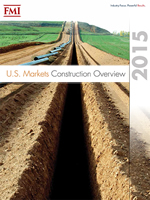Construction- and engineering-geared management consultant FMI Corp. views increased infrastructure spending levels, continued housing activity growth and accelerated market consolidation as linchpins to a successful year. In its U.S. Markets Construction Overview 2015 report, the firm observes:
Infrastructure. Lack of progress in reauthorizing the national highway transportation funding resembles a “Groundhog Day” plot, where the main character relives the same day repeatedly. Each temporary funding extension or new Highway Trust Fund-bolstering proposal comes and goes with no real progress made, FMI contends. While some infrastructure markets have a generally positive funding outlook, there is a growing concern for how the nation will get past the current political grandstanding and solve the underlying funding issues. FMI does not expect the situation to change in Washington, D.C., looking instead to the prospects for more state and local government action.
Housing. A sector where improvement continues, evidenced especially in 2014, when for the first time in years, unit start levels exceeded the 1 million annualized new construction rate. Construction materials producers in areas where housing starts have rebounded are experiencing strong market improvements after what has been a bleak five-plus years. FMI expects new home building to begin to level off in 2015 as inventory levels stabilize in hot markets and mortgage interest rates rise. Even with the leveling, the industry should continue to enjoy improving margins and production volumes as commercial construction activity, which follows new housing development, proceeds.
Consolidation. The last significant trend to watch for in construction materials this new year is accelerated merger and acquisition activity. Among consequences of the impending Holcim Ltd. and Lafarge Group merger, FMI sees a) smaller producers facing increased pressure to merge or acquire in order to maintain competitive economies of scale and geographic footprints; b) downstream vertical integration continuing and perhaps picking up steam as opportunities to grow profitability via large-scale mergers decrease; and, c) increasing likelihood of tighter antitrust scrutiny in markets with only one or two major producers. The Raleigh, N.C.-headquartered firm also sees continued deal making in the wake of the mid-2014 Martin Marietta Materials and Texas Industries Inc. merger.
